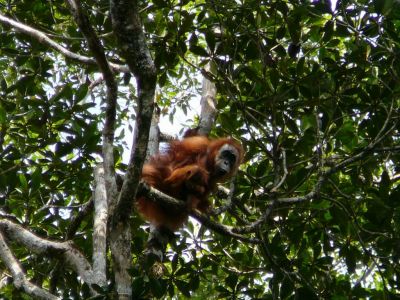Tapanuli Orangutan
Range countries
Indonesia
Population status
The Tapanuli orangutan (Pongo tapanuliensis) is a distinct species of orangutan found exclusively in the forests of the Batang Toru Ecosystem in North Sumatra, Indonesia. The geographic distribution of the Tapanuli orangutan is notably restricted, encompassing an area of approximately 1,000 square kilometers, making it one of the most geographically constrained great ape species (Meijaard et al. 2021). Tapanuli orangutans are classified as critically endangered on the IUCN Red List of threatened species (Nowak et al. 2023). This designation highlights the severity of the threats facing the species and the urgency required for conservation efforts. It has been estimated that fewer than 800 Tapanuli orangutans persist in the wild (Wich et al. 2019).
Threats
The primary threat to the Tapanuli orangutan's existence is habitat loss, a consequence of logging activities, agricultural expansion, and infrastructure development encroaching upon the Batang Toru forest (Meijaard et al. 2021). The ongoing construction of a hydroelectric dam in the area of highest orangutan density is further exacerbating the precarious situation, posing a direct threat to the species and its ecosystem. Mining, hunting, and conflict-killing also threaten Tapanuli orangutans (Meijaard et al. 2021).
Conservation
Since 2005, the Sumatran Orangutan Conservation Programme (SOCP) has worked towards the protection of Batang Toru. After a decade, SOCP has succeeded in establishing protected status for a large proportion of the forests. SOCP works with the Forestry Department of Indonesia to establish management in the field through their Forest Management Unit. SOCP also implements community awareness and education programmes with the communities living near the forest edge and local schools.
The People Resources and Conservation Foundation (PRCF) in partnership with the local grassroots NGO Sumatran Rainforest Institute (SRI) is implementing an ARCUS supported community-based corridor program in South Tapanuli in liaison with five stakeholder villages, aiming to maintain forest cover between Sibual-Buali Nature Reserve and the West Block of the Batang Toru Ecosystem and increase the tolerance towards orangutans in a shared landscape matrix. This corridor program is designed to prevent genetic isolation of orangutans as well as other endangered arboreal species such as Siamang and Agile Gibbons that otherwise become stranded in Sibual-Buali Nature Reserve.
References
Meijaard, E., Ni’matullah, S., Dennis, R., Sherman, J., Onrizal, & Wich, S. A. (2021). The historical range and drivers of decline of the Tapanuli orangutan. PLoS One, 16(1), e0238087.
Wich, S. A., Fredriksson, G., Usher, G., Kühl, H. S., & Nowak, M. G. (2019). The Tapanuli orangutan: Status, threats, and steps for improved conservation. Conservation Science and Practice. ISSN 2578-4854
Nater, A., Mattle-Greminger, M. P., Nurcahyo, A., Nowak, M. G., De Manuel, M., Desai, T., ... & Krützen, M. (2017). Morphometric, behavioral, and genomic evidence for a new orangutan species. Current Biology, 27(22), 3487-3498.
Nowak, M.G., Rianti, P., Wich , S.A., Meijaard, E. & Fredriksson, G. 2023. Pongo tapanuliensis (amended version of 2017 assessment). The IUCN Red List of Threatened Species 2023: e.T120588639A247632253. Accessed on 15 December 2023.
Last updated January 2024
